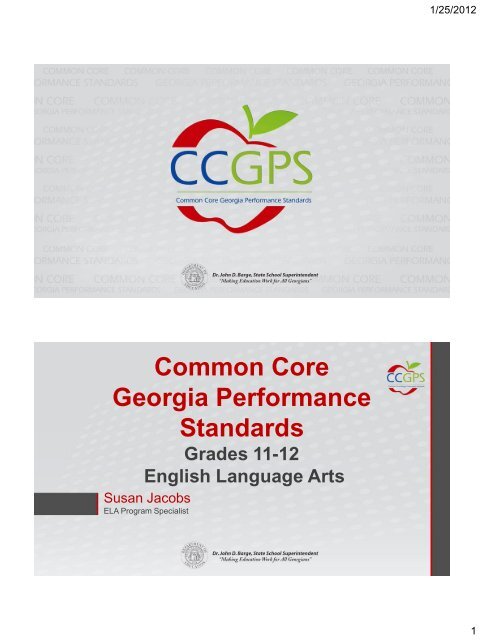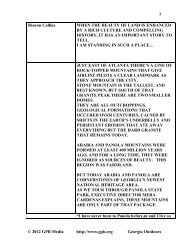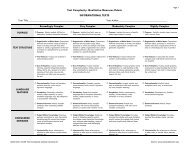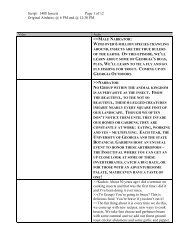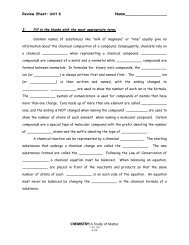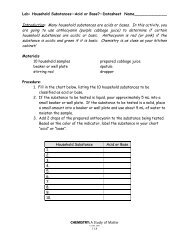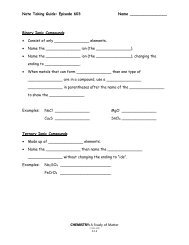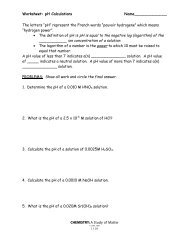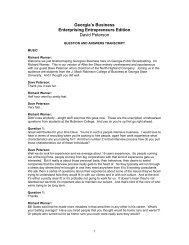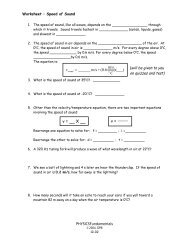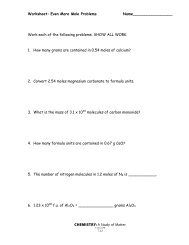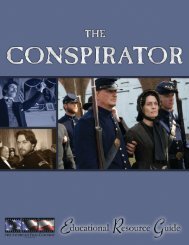11th & 12th Grade Presentation Slides - GeorgiaStandards.org
11th & 12th Grade Presentation Slides - GeorgiaStandards.org
11th & 12th Grade Presentation Slides - GeorgiaStandards.org
You also want an ePaper? Increase the reach of your titles
YUMPU automatically turns print PDFs into web optimized ePapers that Google loves.
1/25/2012Common CoreGe<strong>org</strong>ia PerformanceStandards<strong>Grade</strong>s 11-12English Language ArtsSusan JacobsELA Program Specialist1
1/25/2012WelcomeCommon CoreThe Standards were derived from a set ofanchor standards called the “College andCareer Readiness Standards,” whichrepresent what students should know andbe able to do upon graduation.2
1/25/2012How the CCRs Inform the Common Core:CCR READING STANDARD 1:Read closely to determine what the text says explicitly and tomake logical inferences from it; cite specific textual evidencewhen writing or speaking to support conclusions drawn fromthe text.ELACC11-12RL1: Cite strong and thorough textual evidenceto support analysis of what the text says explicitly as well asinferences drawn from the text, including determining wherethe text leaves matters uncertain.Foundational Resources3
1/25/2012Mirrors GPS in its Main DivisionsAn Integrated Model of Literacy• Processes of communication are closely connected;reading and writing tasks are integrated• Research and media skills are blended into thestandards as a whole• Students will gather, comprehend, evaluate, synthesize,and report on information and ideas to conduct originalresearch in order to answer questions or to solveproblems4
1/25/2012Literacy Standards<strong>Grade</strong> Bands 6-8, 9-10, 11-12Literacy Standards for Reading: History and Social StudiesLiteracy Standards for Reading: Science and TechnicalSubjectsLiteracy Standards for Writing: History, Social Studies,Science, and Technical Subjects***Literacy Standards are embedded in the K-5 ELA Standards of CCGPSAddressing Changes BetweenGPS and CCGPS5
1/25/2012A New Paradigm…“Don’t just take your old state standards out of their boxes and swap inthe Common Core Standards. [The Common Core state standards]are meant as a platform for a new instructional system, not a new listof topics for the old instructional system. […] When we turn standardsinto long lists and we tell teachers to ‘cover’ instead of to teach, whenwe give them pacing plans and tell them to cover everything on thetest, we are ‘covering’ and not learning.”- Phil Daro,Strategic Education Research Partnership, Washington, D.C.Common Core Author, Mathematics6
1/25/2012ELAALRL1 The student demonstrates comprehension by identifying evidence(i.e., examples of diction, imagery, point of view, figurative language,symbolism, plot events and main ideas) in a variety of texts representative ofdifferent genres (i.e., poetry, prose [short story, novel, essay, editorial,biography], and drama) and using this evidence as the basis for interpretation.The student identifies, analyzes, and applies knowledge of the structures andelements of American fiction and provides evidence from the text to supportunderstanding; the student:a. Locates and analyzes such elements in fiction as language and style,character development, point of view, irony, and structures (i.e.,chronological, in medias res, flashback, frame narrative, epistolarynarrative) in works of American fiction from different time periods.b. Identifies and analyzes patterns of imagery or symbolism.c. Relates identified elements in fiction to theme or underlying meaning.d. Analyzes, evaluates, and applies knowledge of the ways authors usetechniques and elements in fiction for rhetorical and aesthetic purposes.e. Analyzes the influence of mythic, traditional, or classical literature onAmerican literature.f. Traces the history of the development of American fiction.The student identifies, analyzes, and applies knowledge of the purpose, structure,and elements of nonfiction and/or informational materials and provides evidence fromthe text to support understanding; the student:a. Analyzes and explains the structures and elements of nonfiction worksof American literature such as letters, journals and diaries, speeches, andessays.b. Analyzes and evaluates the logic and use of evidence in an author’sargument.c. Analyzes, evaluates, and applies knowledge of the ways authors uselanguage, style, syntax, and rhetorical strategies for specific purposes innonfiction works.The student identifies and analyzes elements of poetry from various periods ofAmerican literature and provides evidence from the text to support understanding;the student:a. Identifies, responds to, and analyzes the effects of diction, tone, mood,syntax, sound,form, figurative language, and structure of poems as these elements relateto meaning.i. sound: alliteration, end rhyme, slant rhyme, internal rhyme,consonance, assonanceii. form: fixed and free, lyric, ballad, sonnet, narrative poem,blank verseiii. figurative language: personification, imagery, metaphor,conceit, simile, metonymy, synecdoche, hyperbole, symbolism,allusionb. Analyzes and evaluates the effects of diction and imagery (i.e.,controlling images, figurative language, extended metaphor,understatement, hyperbole, irony, paradox, and tone) as they relate tounderlying meaning.c. Traces the historical development of poetic styles and forms in Americanliterature.The student identifies, analyzes, and applies knowledge of the themes, structures,and elements of dramatic American literature and provides evidence from the text tosupport understanding; the student:a. Identifies and analyzes types of dramatic literature (i.e., political drama,modern drama, theatre of the absurd).b. Analyzes the characters, structures, and themes of dramatic literature.c. Identifies and analyzes dramatic elements, (i.e., stage directions, fourthwall, expressionism, minimalism, dramatic irony).d. Identifies and analyzes how dramatic elements support and enhance theinterpretation of dramatic literature.ELAALRL2 The student identifies, analyzes, and applies knowledge of theme in awork of American literature and provides evidence from the work to supportunderstanding. The studenta. Applies knowledge of the concept that the theme or meaning of a selection representsa universal view or comment on life or society and provides support from the text for theidentified theme.b. Evaluates the way an author’s choice of words advances the theme or purpose of thework.c. Applies knowledge of the concept that a text can contain more than one theme.d. Analyzes and compares texts that express universal themes characteristic of Americanliterature across time and genre (i.e., American individualism, the American dream,cultural diversity, and tolerance) and provides support from the texts for the identifiedthemes.ELAALRL3 The student deepens understanding of literary works by relating them totheir contemporary context or historical background, as well as to works from othertime periods.The student relates a literary work to primary source documents of its literary period orhistorical setting; the student: a. Relates a literary work to the seminal ideas of the time inwhich it is set or the time of its composition.Native American literatureColonial/Revolutionary/National literatureb. Relates a literary work to the characteristics of the literary time period that it represents.i.Romanticism/Transcendentalismii. Realismiii. Naturalismiv. Modernism (including Harlem Renaissance)v. PostmodernismThe student compares and contrasts specific characteristics of different genres as theydevelop and change over time for different purposes (i.e., personal, meditative Colonialwriting vs. public, political documents of the Revolutionary era, or replication of traditionalEuropean styles [Bradstreet, Taylor] vs. emerging distinctive American style [Dickinson,Whitman] in poetry).The student analyzes a variety of works representative of different genres withinspecific time periods in order to identify types of discourse (i.e., satire, parody,allegory) that cross the lines of genre classifications.ELAALRL4 The student employs a variety of writing genres to demonstrate acomprehensive grasp of significant ideas in selected literary works. Thestudent composes essays, narratives, poems, or technical documents. Thestudenta. Demonstrate awareness of an author’s use of stylistic devices and anappreciation of the effects created by the devices.b. Analyze the use of imagery, language, and other particular aspects of a text thatcontribute to theme or underlying meaning.c. Draw comparisons between specific incidents in a text and broader themes thatillustrate the writer’s important beliefs or generalizations about life.d. Analyze multiple, relevant historical records of a single event and examine theircritical relationships to a literary work.e. Include a formal works cited or bibliography when applicable.ELAALRL5 The student understands and acquires new vocabulary and usesit correctly in reading and writing. The studenta. Identifies and correctly uses idioms, cognates, words with literal and figurativemeanings, and patterns of word changes that indicate different meanings orfunctions.b. Uses knowledge of mythology, the Bible, and other works often alluded to inAmerican literature to understand the meanings of new words.c. Uses general dictionaries, specialized dictionaries, thesauruses, or relatedreferences as needed to increase learning.work; andd. the ways in which the poet’s work furthers and/or breaks from prior literarytraditions and informs or affects the traditions and literary works that follow.7
1/25/2012The student identifies, analyzes, and applies knowledge of the structures andelements of American fiction and provides evidence from the text to supportunderstanding; the student:a. Locates and analyzes such elements in fiction as language and style,character development, point of view, irony, and structures (i.e., chronological, inmedias res, flashback, frame narrative, epistolary narrative) in works of Americanfiction from different time periods.b. Identifies and analyzes patterns of imagery or symbolism.c. Relates identified elements in fiction to theme or underlying meaning.d. Analyzes, evaluates, and applies knowledge of the ways authors usetechniques and elements in fiction for rhetorical and aesthetic purposes.e. Analyzes the influence of mythic, traditional, or classical literature on Americanliterature.f. Traces the history of the development of American fiction.The student identifies and analyzes elements of poetry from various periods ofAmerican literature and provides evidence from the text to support understanding;the student:a. Identifies, responds to, and analyzes the effects of diction, tone, mood, syntax,sound, form, figurative language, and structure of poems as these elementsrelate to meaning.i. sound: alliteration, end rhyme, slant rhyme, internal rhyme, consonance,assonanceii. form: fixed and free, lyric, ballad, sonnet, narrative poem, blank verseiii. figurative language: personification, imagery, metaphor, conceit, simile,metonymy, synecdoche, hyperbole, symbolism, allusionb. Analyzes and evaluates the effects of diction and imagery (i.e., controllingimages, figurative language, extended metaphor, understatement, hyperbole,irony, paradox, and tone) as they relate to underlying meaning.c. Traces the historical development of poetic styles and forms in Americanliterature.How will the 11 th and 12 th gradestandards be changing?8
1/25/2012Changes for <strong>Grade</strong>s 11-12 Reading9
1/25/2012Language Progressive Skills10
1/25/2012Exploring the Standards: American Lit ReadingExploring the Standards: <strong>Grade</strong>s 11-12Writing, Language, Listening and Speaking11
1/25/2012Exploring the Standards: <strong>Grade</strong>s 11-12Writing, Language, Listening and SpeakingExploring the Standards: <strong>Grade</strong>s 11-12Writing, Language, Listening and Speaking12
1/25/2012How will daily instruction change?• We will all still be teachers of reading and writing• There is an expectation of great complexity in texts• Informational texts must represent 50% of reading• Tasks will be more integrated and will never be taught in isolation(while you will have focus standards, you will not teach a singlestandard or genre in isolation)• All standards will be mastered through recursive attentionthroughout the four instructional unitsNew Lexile Expectations13
1/25/2012DETERMININGTEXTCOMPLEXITYIntegrated Instruction• http://engageny.<strong>org</strong>/resource/thegettysburg-address-a-curricular-exemplarin-literacy/• David Coleman14
1/25/2012Sample Unit PlanThe Individual versus Society:Exploring a New Frontier<strong>Grade</strong> 11, American Literature,Informational Focus11 th <strong>Grade</strong> Curriculum Map15
1/25/201212 th <strong>Grade</strong> Curriculum MapIDENTIFY DESIRED RESULTSDETERMINE ACCEPTABLEEVIDENCEBACKWARD DESIGNThe big picturePLAN INSTRUCTIONCOLLEGE ANDWORKFORCEREADY: CCGPSGATHER, COMPREHEND,EVALUATE, SYNTHESIZE, ANDREPORT ON INFORMATIONFROM COMPLEX TEXTS,CONDUCT ORIGINALRESEARCH, SOLVEPROBLEMSINTEGRATEDINSTRUCTIONBASED ON MAPS16
1/25/2012IDENTIFY DESIRED RESULTSMeet standards RL1-RL10/RI1-10/W1-10/SL1-6/L1-6GATHER, COMPREHEND,EVALUATE, SYNTHESIZE, ANDREPORT ON INFORMATIONFROM COMPLEX TEXTS,CONDUCT ORIGINAL RESEARCH,SOLVE PROBLEMSDETERMINE ACCEPTABLEEVIDENCEBACKWARD DESIGNIn Unit PlanningPLAN INSTRUCTIONEXTENDED TEXT/SHORT TEXTSANALYSES: INDV. VS. SOCIETYGENDER & IDENTITYPERS AND POL ISSUES IN AMLITINDV VS. NATURERESEARCH: EVOLUTION OF PERSRESPONSIBILITY IN US (ETC.)RESEARCHPEER REVIEWNEWSPAPERMOCK TRIALDEBATEDRAMATIC PRESENTATIONSOCRATIC SEMINARACADEMIC CONFERENCEFIELD TRIP (ETC.)Addressing theReading Standards:Choosing AppropriateTexts17
1/25/2012EvaluateYour Texts18
1/25/2012Finding Lexileshttp://www.lexile.com/analyzer/Addressing the Writing Standards:Constructing Appropriate Writing Prompts19
1/25/2012A Critical and Analytical Focus• Prompts will address HOW an author creates tone,mood, characterization, and other literary effects• Prompts will address WHY the author wishes to achievethese effects• Prompts will NOT address “WHAT”• ALL writing cites specific textual evidenceIn this way we scaffold analysis skills and move away from simple summaryPlanning Tools to Ensure Integration20
1/25/2012DailyInstructionExamples21
1/25/2012AccessingResources22
1/25/2012ResourcesELA Reporter&Joining ourListServjoin-ela-6-8@list.doe.k12.ga.us23
1/25/2012YOUR QUESTIONShttp://survey.sedl.<strong>org</strong>/efm/wsb.dll/s/1g10aKim Jeffcoat, Ge<strong>org</strong>ia ELA Coordinatorkjeffcoat@doe.k12.ga.usSusan Jacobs, Secondary ELAsjacobs@doe.k12.ga.usSallie Mills, Elementary ELAsmills@doe.k12.ga.usAndria Bunner, Elementary ELAabunner@doe.k12.ga.us24
1/25/201225


